|

|
|
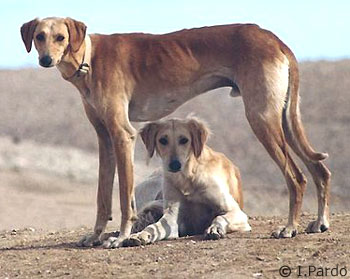
|
|
Written by Dr Zafra Sirik, The Israeli Sighthound club's chairman since
1997. All -Breed international judge (F.C.I.) since 1986, judged a lot
in Scandinavia, Also in Europe, South America, Australia and Russia.
Greyhound breeder (Tigi's). General Surgeon, Ex Lieutenant - Colonel
in the Israeli Medical Force.
The latest version of the saluki standard defines very well, in my
opinion, the variation of the saluki breed as being one of its main
characteristics.
The desert
bred variety in the Israeli desert is unique in type, performance
and health and will be presented in this article, based on the presentation
at the World Congress of Sighthounds held on 10/5/2002 in Belgium.
The Middle
East is the original home of the saluki. It is well documented that
the first salukis in the UK arrived from the Middle East. The "Amherstia"
salukis were founded on salukis brought from Egypt by Florence Amherst
in 1897.
The "Sarona
salukis" were brought from Syria by Brigadier Lance in the early
20's, as were the "Nablous salukis" which arrived in England
from British-ruled Palestine with Miss Mitchell who served as a nurse
in the Nablus hospital.
The Palestine
Kennel Club (PKC) was established in 1939 by Prof, Rudolfina and Dr
Rudolf Menzel and their friends. An immigrants from Nazi Austria,
the Menzels arrived in Palestine with their boxers. She was a well
known cynologist and a unique personality, and she laid the foundation
for the dog hobby in Palestine and later in the state of Israel.
The 4th
show of the PKC was held in Jerusalem at the Y.M.C.A. grounds on the
19th of June 1942 , under the patronage of Lady MacMichel, wife of
the British Supreme Commissioner. Four registered salukis were shown,
one of them in the veteran class.
|
|
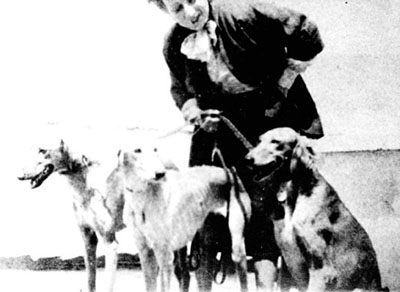
|
|
The next show was held in Haifa, on the 23rd of October
1943, under the patronage of Brigadier General I.C. Cameron, In aid
of the British Red Cross. The salukis shown there were from different
kennels - "Beit Habar" and "Transjordania". We also know the "Propatria"
kennel from those years.
The
few photographs that I have managed to collect from those years show
the same type of dogs that arrived in the UK, elegant, feathered coat,
all known colours.
Sheikh
Suliman El Huzeil was one of the most outstanding of the Bedouin leaders
in the Israeli Negev desert in the 50's and 60's. His tribe "El Huzeil"
lived a bit north of Beer- Sheba where the Bedouin city of Rahat is
located today. He was a colourful man known especially for his pure
Arabian horses, hunting Salukis, and more than 30 wives…. It
was difficult to count his offsprings. One of his wives was a blue
eyed Danish girl who converted to Islam.
Sheikh
Suliman was well connected, and during the 50's, despite the closed
border he got some royal salukis from Jordan. Some of the dogs he
bred were gifted to Israeli police and army officers and they were
shown in the IKC shows.
The
Israel Sighthound Club (ISC) was established in 1968. Only 2 breeds
of sighthounds were represented in Israel at that time. The Turkuman
Afghans that arrived with the famous herbalist, Juliette Barcaly De
Levy, and the local Salukis , mostly from El Huzeil , but some came
from Jordan and some from Persia (Iran of today). The most famous
of them was a black well feathered dog called Mobi.
|
|
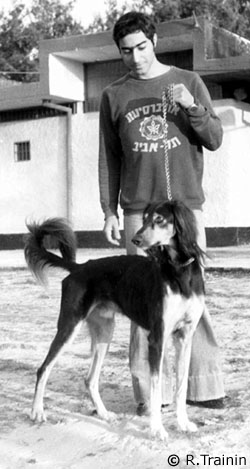
|
|
Hoki was one of the first local Champions of the breed, bred from
the Persian Mobi and the El Huzeil's Rina. A strongly feathered dog
that was also a champion in high jump.
The year 1967 was the turning point for the Israeli salukis. The Sinai
desert was occupied in the swift Six Days War, and a new era began for
us, Salukis lovers. Most of the Israelis, including myself and my friends,
fell in love with this desert terrain. The magic of Sinai is the breathless
combination of high granite mountains, majestic canyons, peaceful beaches
and for us, sighthound enthusiasts, there were salukis! Plenty of salukis.
With every camel caravan that moved along the trails there were a few
salukis..
|
|
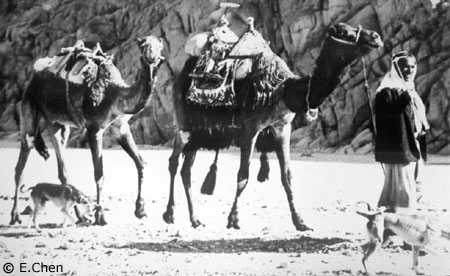
|
|
We traveled often to Sinai, until it's return to Egypt in 1982. Igal
Sella was the one who travelled most as he worked as a guide in the
Society for the Preservation of Nature in Israel. He made a lot of
contacts among the Bedouins, especially among the Tarabin tribe. Thanks
to his contacts he recieved his first bitch, called Ruach (wind in
Hebrew).
The first
litter in his "Tarabin" kennel was born in 1970, Sired by
Lobo El Huzeil out of Ruach. Igal acquired many salukis from the Tarabin
Bedouins but he also returned them numerous puppies born in his kennel
in Bustan Hagalil. Igal was not the only one who got salukis from
Sinai, the Israeli Bedouins also exchanged dogs with the Sinai Bedouins
and used them in their breeding.
|
|
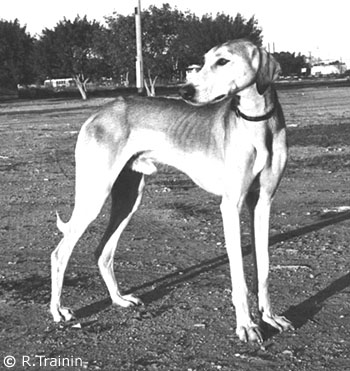
|
|
Thanks
to Igal's initiative the salukis were allowed to participate in an
official hunt in order to cull the gazelle population in the north
of the country during 1973. One of the best hunters and coursers was
Tarabin Salag, owned by Aviva Neeman, the ISC's secretary on those
days.
The
Sinai Salukis were a bit different from the few European imports to
Israel in those days. They were stronger, somewhat coarser, and usually
short coated. They had endurance and stamina and very good hunting
qualities.
The
few European and Scandinavian judges who came to judge in our shows
increased the discussion around this variety and led the way to the
ISC's decision to split the breed into Salukis and Sloughis in 1974.
We
have to bear in mind that during the early 70's Sloughis were not
as common as they are today in Europe, and now we can look back on
this decision with a bit of forgiving criticism.
The
IKC breeding regulations allow the registration of only two
breeds born in desert origin - the Dog of Canaan and the Saluki.
|
|
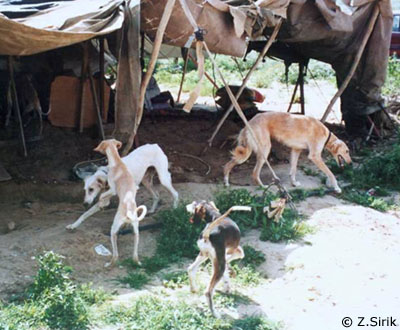
|
|
The 70's were the golden time for the Israeli Salukis. They were attractive
to many people, numerous Israelis who worked in Sinai got themselves
a Saluki, new breeders joined, the entry in shows grew and many salukis
participated in the coursing organized by the ISC.
The decline
of the salukis took place in the late 80's and the beginning of the
90's. The fact that Igal Sella stopped breeding had great influence
on the activities of the breed. Igal found it more and more difficult
to let the salukis perform their hunting skills due to legal restrictions
and a shortage of open spaces.
New registrations
in 1976 were 27 Salukis and 18 Sloughis but in 1986 there were only
21 Salukis and no Sloughis. During 1994-1996 there was no registration
of any litter and real decline in show entries for the breed was noted.
In 1997
when I was elected to the chairman of the ISC, I puzzled myself with
the mystery of where all the beautiful salukis had gone. I decided
to conduct a mini survey. We went south several times, met the Bedouin
Saluki breeders and looked around. What we found was quite amazing.
|
|
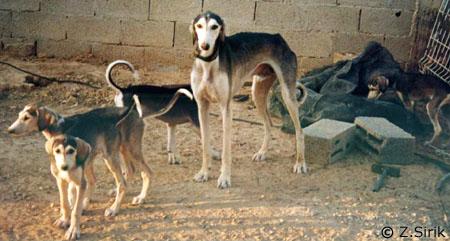
|
|
The Bedouin population in Israel is rather small, only some 130,000
out of a total population of close to 6 million people. Most of them
live in the Negev, more than half of them live in villages, and the
rest in 7 Bedouin cities built specially for them by the government.
The Bedouin society in Israel has gone through dramatic changes. The
house replaced the tent, the Subaru replaced the camel and the city
replaced the village.
The best
surprise was to find so many good Salukis bred by some of the Bedouin
breeders. Although they have no written pedigrees they know each dog's
lineage by heart.
Although
hunting with dogs is illegal in Israel they do practice active hunting
and their Salukis hunt everything, hares, gazelles and ibex. This
illegal hunting causes them endless collisions with the wardens in
charge of the protection of wild animals who, at times hunt and kill
the Salukis, although sometimes they just catch them and deport them
to boarding kennels.
|
|
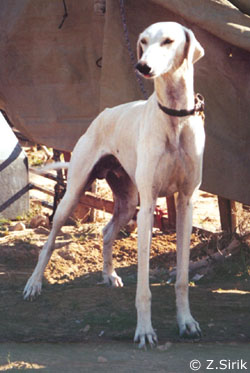
|
|
We found Saluki populations in different areas, in Rahat, Tel Sheba,
Kalansua, El Huashla, in the Arava, and also in some non-Bedouin Arab
villages in northern Israel. All of them are bred for functionality
and performance and not for shows so the best hunter is the most popular
stud. And the Bedouins still follow ancient traditions today, and
sit for hours, drinking coffee relating stories about the famous dogs
and their hunting prowess.
The poor
socio-economic status does reflect in high puppy morbidity and mortality,
but once the puppy has survived, he is very healthy with good bone,
good bite and extremely light movement. The natural selection makes
these dogs suitable for their job which is to hunt. This is really
the survival of the fittest. No artificial insemination, no defective
bites or dentition, no other hereditary problems.
The findings
were very encouraging and we decided that the preservation of the
Negev type Saluki will be the main goal of the ISC, along with other
goals to promote the sighthound breeds. We adopted a strategy of close
follow up and direct support of the Bedouins breeders without interfering
in their breeding program. Here is how we do it -
1. We
tattoo & photograph all puppies and adults brought to us during
regular visits.
2. We selectively register some of the dogs in the IKC stud book.
Only one variety is registered - Saluki. The Bedouins are not keen
to have pedigrees and cannot pay the expense, the IKC is very cooperative
in this matter.
3. We provide food and vaccinations at our own expense.
4. We try our best to convince them, especially the young breeders
- not to mix the Salukis with other sighthound breeds like greyhounds
or whippets.
5. We try to educate them not to overuse their bitches.
|
|
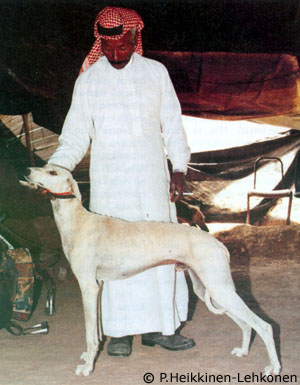
|
|
It took a long time to build up the trust between us. Some of them
still expect a greyhound puppy from me… but most of them have
a lot of fun and take much pride in being Saluki breeders. The interest
and curiosity that our guests in their dogs - most of these guests
being foreign judges and "experts" - make them feel proud and important.
We also share with them every bit of copy published - whether in the
Sighthound Review, the Finnish Koiramme ETC, and give them copies
of the photos I take. All this build strong relations.
After
almost 5 years of work with the Israeli Bedouins' Salukis we are beginning
to see some fruits. The stud book registrations have increased and
we now register over 30 puppies each year. Show entries have grown
slowly and now are almost parallel to the Whippet entries and Whippets
are still the leading breed in our club.
|
|
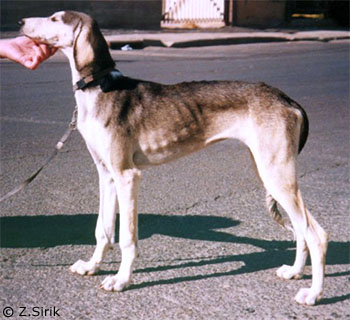
|
|
Due
to the published articles about our salukis on the Internet and professional
magazines we exported 3 puppies, 2 to Finland and one to Germany. We
keep contact with their development and so far they have given us a
lot of pride and satisfaction.
But most
rewarding of all is the new interest in desert bred Salukis awakening
among Israelis themselves. Along with Shalom Shtokelman and his 30
years old kennel, "Arava", some new Israeli breeders have joined the
scene. Kuti Aharon and Tzviah Idan recently established the "Idan
Atiq" kennels and work very closely with the leading Bedouin Saluki
breeder, Jumaa El Abeid. Shai Spector's "Spector El Razal" kennel
combine desert bred and Scandinavian imports of the breed.
Without
the help of those I've mentioned and others like Andrea Diaconasa
our mission, of preserving the 'Negev-Type' Saluki could not be accomplished.
|
|
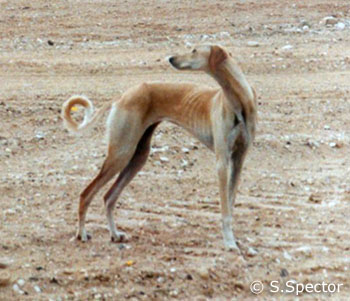
|
|
Summary:
THE POPULATION OF DESERT BRED SALUKIS IN ISRAEL IS HEALTHY , WITH NO
KNOWN HEREDITARY DISEASES.
THE "NEGEV- TYPE" SALUKI HAS STRONG ROOTS IN THE REGION INCLUDING THE
SINAI PENINSULA.
THE BEDOUINS BREED FOR PERFORMANCE, NOT FOR SHOWS.
THE ISC'S GOAL IS TO PRESERVE THE "NEGEV -TYPE" SALUKI - THE MOST SUITABLE
WORKING HOUND FOR THE REGION.
|










